Ecological Security Pattern Construction for Carbon Sink Capacity Enhancement: The Case of Chengdu Metropolitan Area
Abstract
1. Introduction
- (1)
- What were the spatial and temporal characteristics of the ecological network and carbon sink capacity in the CMA from 2000 to 2020?
- (2)
- Does a significant relationship exist between the topological structure of the ecological network and its carbon sink capacity?
- (3)
- What strategies can be developed to optimize the ecological network structure and improve carbon sink potential in metropolitan regions?
2. Materials and Methods
2.1. Study Area
2.2. Data Source and Processing
2.3. Methods
2.3.1. Ecological Security Pattern Construction
- (1)
- Identification of ecological sources based on MSPA
- (2)
- Constructing resistance surfaces
- (3)
- Extraction of potential ecological corridors
- (4)
- Screening ecological corridors
2.3.2. Ecospatial Network Topology
2.3.3. Calculation of Carbon Sequestration Capacity
3. Results
3.1. Ecological Security Pattern Construction and Analysis
3.1.1. Identification and Analysis of Ecological Source Site
3.1.2. Analysis of Resistance Surfaces
3.1.3. Ecological Corridor Analysis
3.2. Topological Characteristics of the Ecospatial Network
3.2.1. Topological Network Structure Overview
3.2.2. Degree and Betweenness Centrality
3.2.3. Proximity Centrality and Clustering Coefficients
3.2.4. Eigenvector Centrality and PageRank
3.3. Correlation Analysis Between Carbon Sequestration Calculations and Ecological Network Structure
3.3.1. Calculation of Carbon Sequestration
3.3.2. Analysis of the Relationship Between Ecological Network Structure and Carbon Sequestration Capacity
4. Discussion
4.1. Optimizing Regional Ecological Security Patterns to Enhance Regional Carbon Sequestration
4.2. Strengths and Recommendations
4.3. Limitations and Challenges
5. Conclusions
- (1)
- Between 2000 and 2020, the area of ecological source sites first expanded and then declined, indicating an increase in regional ecological fragmentation. Ecological resistance displayed a spatial pattern of “high in the center and low at the edges”, with ecological networks concentrated in the west, while ecological foundations in the central and eastern areas remained weak and urgently require enhancement.
- (2)
- The ecological spatial network exhibited signs of degradation, with network modules decreasing from three to two. Although the core area remained stable, the southeastern region became marginalized due to corridor disruptions, and key topological indicators declined, reflecting diminished connectivity.
- (3)
- Forests consistently served as the primary carbon sink (>70%) and exhibited significant correlations with multiple network metrics. Grassland sinks were influenced by clustering coefficients, while water bodies showed positive associations with centrality, highlighting their role in localized connectivity.
- (4)
- The addition of 10 new stepping stones and 45 ecological corridors in 2020 increased the annual carbon sink capacity by 4.16 million C yr−1, with forest ecosystems contributing up to 94.8%, significantly enhancing network connectivity and supporting regional carbon neutrality goals.
Supplementary Materials
Author Contributions
Funding
Institutional Review Board Statement
Informed Consent Statement
Data Availability Statement
Conflicts of Interest
Abbreviations
| ESP | Ecological Security Pattern |
| CMA | Chengdu Metropolitan Area |
| MSPA | Morphological Spatial Pattern Analysis |
| MCR | Minimum Cumulative Resistance |
| NDVI | Normalized Difference Vegetation Index |
| ENVI | Environment for Visualizing Images |
| PC | Potential connectivity |
| DPC | Delta Probability of Connectivity |
| ArcGIS | Geographic Information System |
| DEM | Digital Elevation Model |
| LUCC | Land Use and Land Cover Change |
| AHP | Analytic Hierarchy Process |
| GM | Gravity Model |
References
- AghaKouchak, A.; Chiang, F.; Huning, L.S.; Love, C.A.; Mallakpour, I.; Mazdiyasni, O.; Moftakhari, H.; Papalexiou, S.M.; Ragno, E.; Sadegh, M. Climate Extremes and Compound Hazards in a Warming World. Annu. Rev. Earth Planet. Sci. 2020, 48, 519–548. [Google Scholar] [CrossRef]
- Yang, T.; Dong, Q.; Du, Q.; Du, M.; Dong, R.; Chen, M. Carbon Dioxide Emissions and Chinese OFDI: From the Perspective of Carbon Neutrality Targets and Environmental Management of Home Country. J. Environ. Manag. 2021, 295, 113120. [Google Scholar] [CrossRef] [PubMed]
- Sun, L.-L.; Cui, H.-J.; Ge, Q.-S. Will China Achieve Its 2060 Carbon Neutral Commitment from the Provincial Perspective? Adv. Clim. Change Res. 2022, 13, 169–178. [Google Scholar] [CrossRef]
- Lai, S.; Lu, J.; Luo, X.; Ge, J. Carbon Emission Evaluation Model and Carbon Reduction Strategies for Newly Urbanized Areas. Sustain. Prod. Consum. 2022, 31, 13–25. [Google Scholar] [CrossRef]
- Zhang, X.; Cui, X.; Liang, S. Evolution and Optimization of an Ecological Network in an Arid Region Based on MSPA-MCR: A Case Study of the Hexi Corridor. Sustainability 2024, 16, 1704. [Google Scholar] [CrossRef]
- Huo, J.; Shi, Z.; Zhu, W.; Li, T.; Xue, H.; Chen, X.; Yan, Y.; Ma, R. Construction and Optimization of an Ecological Network in Zhengzhou Metropolitan Area, China. Int. J. Environ. Res. Public Health 2022, 19, 8066. [Google Scholar] [CrossRef]
- Wu, S.; Shi, S.; Zhang, J. Evolution Analysis of Ecological Security Pattern in Forest Areas Coupling Carbon Storage and Landscape Connectivity: A Case Study of the Xiaoxing’an Mountains, China. Forests 2025, 16, 331. [Google Scholar] [CrossRef]
- Xu, W.; Wang, J.; Zhang, M.; Li, S. Construction of Landscape Ecological Network Based on Landscape Ecological Risk Assessment in a Large-Scale Opencast Coal Mine Area. J. Clean. Prod. 2021, 286, 125523. [Google Scholar] [CrossRef]
- Yan, Y.; Jarvie, S.; Zhang, Q.; Zhang, S.; Han, P.; Liu, Q.; Liu, P. Small Patches Are Hotspots for Biodiversity Conservation in Fragmented Landscapes. Ecol. Indic. 2021, 130, 108086. [Google Scholar] [CrossRef]
- Zhang, F.; Jia, Y.; Liu, X.; Li, T.; Gao, Q. Application of MSPA-MCR Models to Construct Ecological Security Pattern in the Basin: A Case Study of Dawen River Basin. Ecol. Indic. 2024, 160, 111887. [Google Scholar] [CrossRef]
- Chen, J.; Wang, S.; Zou, Y. Construction of an Ecological Security Pattern Based on Ecosystem Sensitivity and the Importance of Ecological Services: A Case Study of the Guanzhong Plain Urban Agglomeration, China. Ecol. Indic. 2022, 136, 108688. [Google Scholar] [CrossRef]
- Wei, Q.; Halike, A.; Yao, K.; Chen, L.; Balati, M. Construction and Optimization of Ecological Security Pattern in Ebinur Lake Basin Based on MSPA-MCR Models. Ecol. Indic. 2022, 138, 108857. [Google Scholar] [CrossRef]
- Lin, J.; Yang, W.; Yu, K.; Geng, J.; Liu, J. Identification and Construction of Ecological Nodes in the Fuzhou Ecological Corridors. Forests 2022, 13, 1837. [Google Scholar] [CrossRef]
- Wang, T.; Huang, Y.; Cheng, J.; Xiong, H.; Ying, Y.; Feng, Y.; Wang, J. Construction and Optimization of Watershed-Scale Ecological Network Based on Complex Network Method: A Case Study of Erhai Lake Basin in China. Ecol. Indic. 2024, 160, 111794. [Google Scholar] [CrossRef]
- Wu, X.; Pan, J.; Zhu, X. Optimizing the Ecological Source Area Identification Method and Building Ecological Corridor Using a Genetic Algorithm: A Case Study in Weihe River Basin, NW China. Ecol. Inform. 2024, 80, 102519. [Google Scholar] [CrossRef]
- Zhao, J.; Li, Z.; Wu, J.; Xu, Z.; Ja, B. Ecological Spatial Network Optimization of Carbon Sink Patches for Enhanced Carbon Sink in Wuhan Metropolitan Area, China. Ecol. Indic. 2024, 165, 112177. [Google Scholar] [CrossRef]
- Liang, X.; Liu, Z.; Zhai, L.; Ji, L.; Feng, Y.; Sang, H. Spatial Terrestrial Carbon Emissions/Sequestrations Evolution Based on Ecological Network Analysis in Beijing-Tianjin-Hebei Urban Agglomeration. Ecol. Eng. 2023, 189, 106914. [Google Scholar] [CrossRef]
- Zhu, N.; Ai, J.; Zeng, Z.; Zhou, C. Exploring the Spatial Relationship between the Ecological Topological Network and Carbon Sequestration Capacity of Coastal Urban Ecosystems: A Case Study of Yancheng City, China. Remote Sens. 2023, 15, 4007. [Google Scholar] [CrossRef]
- Guo, H.; Yu, Q.; Pei, Y.; Wang, G.; Yue, D. Optimization of Landscape Spatial Structure Aiming at Achieving Carbon Neutrality in Desert and Mining Areas. J. Clean. Prod. 2021, 322, 129156. [Google Scholar] [CrossRef]
- Qiu, S.; Fang, M.; Yu, Q.; Niu, T.; Liu, H.; Wang, F.; Xu, C.; Ai, M.; Zhang, J. Study of Spatial temporal Changes in Chinese Forest Eco-Space and Optimization Strategies for Enhancing Carbon Sequestration Capacity through Ecological Spatial Network Theory. Sci. Total Environ. 2023, 859, 160035. [Google Scholar] [CrossRef]
- Fang, M.; Si, G.; Yu, Q.; Huang, H.; Huang, Y.; Liu, W.; Guo, H. Study on the Relationship between Topological Characteristics of Vegetation Ecospatial Network and Carbon Sequestration Capacity in the Yellow River Basin, China. Remote Sens. 2021, 13, 4926. [Google Scholar] [CrossRef]
- Wan, Y.; Wang, Y.; Gao, M.; Jin, L. An Empirical Assessment of Whether Urban Green Ecological Networks Have the Capacity to Store Higher Levels of Carbon. Sci. Rep. 2024, 14, 3132. [Google Scholar] [CrossRef] [PubMed]
- Chen, H.; Yan, W.; Li, Z.; Wende, W.; Xiao, S. A Framework for Integrating Ecosystem Service Provision and Connectivity in Ecological Spatial Networks: A Case Study of the Shanghai Metropolitan Area. Sustain. Cities Soc. 2024, 100, 105018. [Google Scholar] [CrossRef]
- Huang, K.; Peng, L.; Wang, X.; Deng, W.; Liu, Y. Incorporating Circuit Theory, Complex Networks, and Carbon Offsets into the Multi-Objective Optimization of Ecological Networks: A Case Study on Karst Regions in China. J. Clean. Prod. 2023, 383, 135512. [Google Scholar] [CrossRef]
- Huang, L.; Wang, J.; Cheng, H. Spatiotemporal Changes in Ecological Network Resilience in the Shandong Peninsula Urban Agglomeration. J. Clean. Prod. 2022, 339, 130681. [Google Scholar] [CrossRef]
- Wang, L.; Zhao, J.; Lin, Y.; Chen, G. Exploring Ecological Carbon Sequestration Advantage and Economic Responses in an Ecological Security Pattern: A Nature-Based Solutions Perspective. Ecol. Model. 2024, 488, 110597. [Google Scholar] [CrossRef]
- Kang, J.; Zhang, X.; Zhu, X.; Zhang, B. Ecological Security Pattern: A New Idea for Balancing Regional Development and Ecological Protection. A Case Study of the Jiaodong Peninsula, China. Glob. Ecol. Conserv. 2021, 26, e01472. [Google Scholar] [CrossRef]
- Shi, Q.; Lu, J.; Han, J. Studying the Spatiotemporal Variations of the Ecological Network and Carbon Utilization Efficiency in Southeast Tibet Based on Complex Network Theory. Ecol. Indic. 2024, 166, 112521. [Google Scholar] [CrossRef]
- Shuai, N.; Hu, Y.; Gao, M.; Guo, Z.; Bai, Y. Construction and Optimization of Ecological Networks in Karst Regions Based on Multi-Scale Nesting: A Case Study in Guangxi Hechi, China. Ecol. Inform. 2023, 74, 101963. [Google Scholar] [CrossRef]
- Men, D.; Pan, J. Incorporating Network Topology and Ecosystem Services into the Optimization of Ecological Network: A Case Study of the Yellow River Basin. Sci. Total Environ. 2024, 912, 169004. [Google Scholar] [CrossRef]
- Yang, W.; Pan, J. The Role of Vegetation Carbon Sequestration in Offsetting Energy Carbon Emissions in the Yangtze River Basin, China. Environ. Dev. Sustain. 2024, 26, 22689–22714. [Google Scholar] [CrossRef]
- Wang, F.; Guo, H.; Zhang, Q.; Yu, Q.; Xu, C.; Qiu, S. Optimizing Ecological Spatial Network Topology for Enhanced Carbon Sequestration in the Ecologically Sensitive Middle Reaches of the Yellow River, China. Remote Sens. 2023, 15, 2308. [Google Scholar] [CrossRef]
- Meng, B.; Wang, X.; Zhang, Z.; Huang, P. Spatio-Temporal Pattern and Driving Force Evolution of Cultivated Land Occupied by Urban Expansion in the Chengdu Metropolitan Area. Land 2022, 11, 1458. [Google Scholar] [CrossRef]
- Chengdu Bureau of Statistics. Chengdu Statistical Yearbook 2023; Chengdu Bureau of Statistics: Chengdu, China, 2023. Available online: https://www.stats.gov.cn/sj/ndsj/2023/indexeh.htm (accessed on 30 January 2025).
- Ministry of Ecology and Environment of the People’s Republic of China. Annual Report on China’s Policies and Actions for Addressing Climate Change 2022; Ministry of Ecology and Environment of the People’s Republic of China: Beijing, China, 2022.
- Xia, X.; Zhang, Y.; Shi, X.; Chen, J.; Rao, T. Simulation of Dynamic Urban Growth Boundary Combining Urban Vitality and Ecological Networks: A Case Study in Chengdu Metropolitan Area. Land 2022, 11, 1793. [Google Scholar] [CrossRef]
- Shen, J.; Zhu, W.; Peng, Z.; Wang, Y. Improving Landscape Ecological Network Connectivity in Urbanizing Areas from Dual Dimensions of Structure and Function. Ecol. Model. 2023, 482, 110380. [Google Scholar] [CrossRef]
- Huang, X.; Wang, H.; Shan, L.; Xiao, F. Constructing and Optimizing Urban Ecological Network in the Context of Rapid Urbanization for Improving Landscape Connectivity. Ecol. Indic. 2021, 132, 108319. [Google Scholar] [CrossRef]
- Luo, Y.; Wu, J.; Wang, X.; Zhao, Y.; Feng, Z. Understanding Ecological Groups under Landscape Fragmentation Based on Network Theory. Landsc. Urban Plan. 2021, 210, 104066. [Google Scholar] [CrossRef]
- Li, J.; Liang, L.; Chao, Y.; Wang, X.; Qiu, M.; Luo, P.; Zhu, Y. Construction of the Ecological Security Pattern of Mu Us Sandy Land on the Basis of the “Source−Resistance−Corridor” Theory. Ecol. Indic. 2025, 171, 113162. [Google Scholar] [CrossRef]
- Knaapen, J.P.; Scheffer, M.; Harms, B. Estimating Habitat Isolation in Landscape Planning. Landsc. Urban Plan. 1992, 23, 1–16. [Google Scholar] [CrossRef]
- Nie, W.; Shi, Y.; Siaw, M.J.; Yang, F.; Wu, R.; Wu, X.; Zheng, X.; Bao, Z. Constructing and Optimizing Ecological Network at County and Town Scale: The Case of Anji County, China. Ecol. Indic. 2021, 132, 108294. [Google Scholar] [CrossRef]
- Fu, Y.; Shi, X.; He, J.; Yuan, Y.; Qu, L. Identification and Optimization Strategy of County Ecological Security Pattern: A Case Study in the Loess Plateau, China. Ecol. Indic. 2020, 112, 106030. [Google Scholar] [CrossRef]
- Feng, M.; Zhao, W.; Zhang, T. Construction and Optimization Strategy of County Ecological Infrastructure Network Based on MCR and Gravity Model—A Case Study of Langzhong County in Sichuan Province. Sustainability 2023, 15, 8478. [Google Scholar] [CrossRef]
- Xu, X.; Wang, S.; Rong, W. Construction of Ecological Network in Suzhou Based on the PLUS and MSPA Models. Ecol. Indic. 2023, 154, 110740. [Google Scholar] [CrossRef]
- Wanghe, K.; Guo, X.; Wang, M.; Zhuang, H.; Ahmad, S.; Khan, T.U.; Xiao, Y.; Luan, X.; Li, K. Gravity Model Toolbox: An Automated and Open-Source ArcGIS Tool to Build and Prioritize Ecological Corridors in Urban Landscapes. Glob. Ecol. Conserv. 2020, 22, e01012. [Google Scholar] [CrossRef]
- Guan, H.; Bai, Y.; Tang, Y.; Zhang, C.; Zou, J. Spatial Identification and Optimization of Ecological Network in Desert-Oasis Area of Yellow River Basin, China. Ecol. Indic. 2023, 147, 109999. [Google Scholar] [CrossRef]
- Liu, H.; Niu, T.; Yu, Q.; Yang, L.; Ma, J.; Qiu, S.; Wang, R.; Liu, W.; Li, J. Spatial and Temporal Variations in the Relationship between the Topological Structure of Eco-Spatial Network and Biodiversity Maintenance Function in China. Ecol. Indic. 2022, 139, 108919. [Google Scholar] [CrossRef]
- Woodbury, P.B.; Smith, J.E.; Heath, L.S. Carbon Sequestration in the U.S. Forest Sector from 1990 to 2010. For. Ecol. Manag. 2007, 241, 14–27. [Google Scholar] [CrossRef]
- Qiu, S.; Yu, Q.; Niu, T.; Fang, M.; Guo, H.; Liu, H.; Li, S.; Zhang, J. Restoration and Renewal of Ecological Spatial Network in Mining Cities for the Purpose of Enhancing Carbon Sinks: The Case of Xuzhou, China. Ecol. Indic. 2022, 143, 109313. [Google Scholar] [CrossRef]
- Qiu, S.; Yu, Q.; Niu, T.; Fang, M.; Guo, H.; Liu, H.; Li, S. Study on the Landscape Space of Typical Mining Areas in Xuzhou City from 2000 to 2020 and Optimization Strategies for Carbon Sink Enhancement. Remote Sens. 2022, 14, 4185. [Google Scholar] [CrossRef]
- Zhu, J.; Hu, H.; Tao, S.; Chi, X.; Li, P.; Jiang, L.; Ji, C.; Zhu, J.; Tang, Z.; Pan, Y.; et al. Carbon Stocks and Changes of Dead Organic Matter in China’s Forests. Nat. Commun. 2017, 8, 151. [Google Scholar] [CrossRef]
- Huang, L.; Liu, J.; Shao, Q.; Xu, X. Carbon Sequestration by Forestation across China: Past, Present, and Future. Renew. Sustain. Energy Rev. 2012, 16, 1291–1299. [Google Scholar] [CrossRef]
- Batjes, N.H. Technologically Achievable Soil Organic Carbon Sequestration in World Croplands and Grasslands. Land Degrad. Dev. 2019, 30, 25–32. [Google Scholar] [CrossRef]
- Wang, Y.; Li, M.; Jin, G. Exploring the Optimization of Spatial Patterns for Carbon Sequestration Services Based on Multi-Scenario Land Use/Cover Changes in the Changchun-Jilin-Tumen Region, China. J. Clean. Prod. 2024, 438, 140788. [Google Scholar] [CrossRef]
- Xiong, Z.; Zhang, Y.; Liang, J.; Chen, Z.; He, L.; Yin, K. A New Method of Estimating Carbon Sequestration and Its Efficiency in Coastal Waters. Prog. Oceanogr. 2024, 226, 103289. [Google Scholar] [CrossRef]
- Chen, J.; Sun, Y.; Liu, H. Survey and Research on Carbon Inclusion Mechanisms in Sichuan Province—The Case of Chengdu’s “Carbon Inclusion Tianfu”. Low Carbon World 2022, 12, 40–42. [Google Scholar]
- Liu, Y.; Wang, L.; Lu, Y.; Zou, Q.; Yang, L.; He, Y.; Gao, W.; Li, Q. Identification and Optimization Methods for Delineating Ecological Red Lines in Sichuan Province of Southwest China. Ecol. Indic. 2023, 146, 109786. [Google Scholar] [CrossRef]
- Cárdenas, J.P.; Santiago, A.; Tarquis, A.M.; Losada, J.C.; Borondo, F.; Benito, R.M. Soil porous system as heterogeneous complex network. Geoderma 2010, 160, 13–21. [Google Scholar] [CrossRef]
- Costa, L.D.F.; Rodrigues, F.A.; Travieso, G.; Boas, P.R.V. Characterization of complex networks: A survey of measurements. Adv. Phys. 2007, 56, 167–242. [Google Scholar] [CrossRef]
- Brandes, U. A faster algorithm for betweenness centrality. J. Math. Sociol. 2001, 25, 163–177. [Google Scholar] [CrossRef]
- Lancichinetti, A.; Fortunato, S. Consensus clustering in complex networks. Sci. Rep. 2012, 2, 336. [Google Scholar] [CrossRef]
- Tandon, A.; Albeshri, A.; Thayananthan, V.; Alhalabi, W.; Fortunato, S. Fast consensus clustering in complex networks. Phys. Rev. E 2019, 99, 042301. [Google Scholar] [CrossRef] [PubMed]
- Huang, X.; Xiu, L.; Lu, Z.; Wang, J. Ecological Networks Construction and Optimization in the Longdong Loess Plateau: The Advantages of Self-Organizing Map and Complex Networks. Ecol. Indic. 2025, 170, 113138. [Google Scholar] [CrossRef]
- Newman, M.E.J. Modularity and community structure in networks. Proc. Natl. Acad. Sci. USA 2006, 103, 8577–8582. [Google Scholar] [CrossRef] [PubMed]

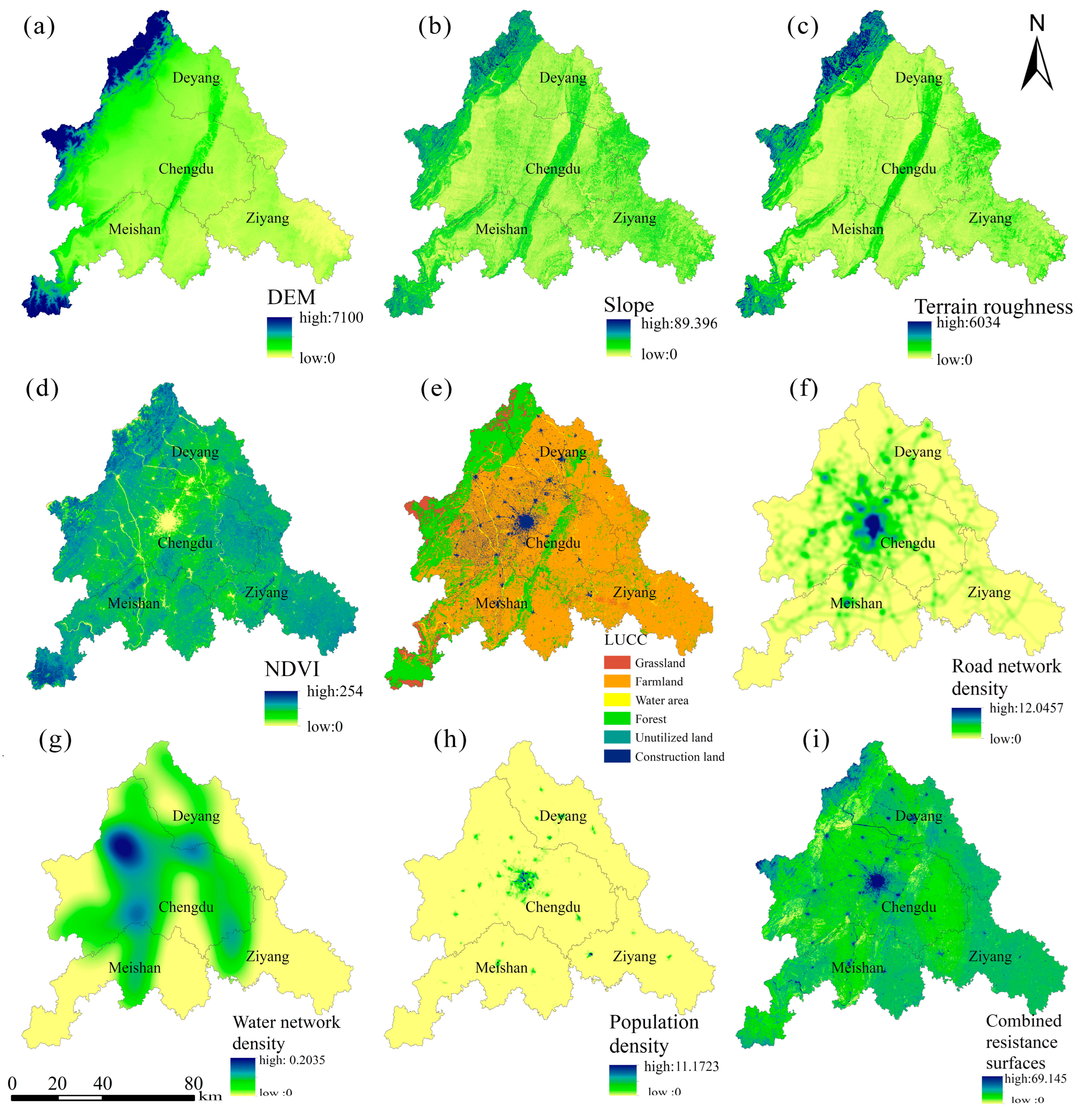
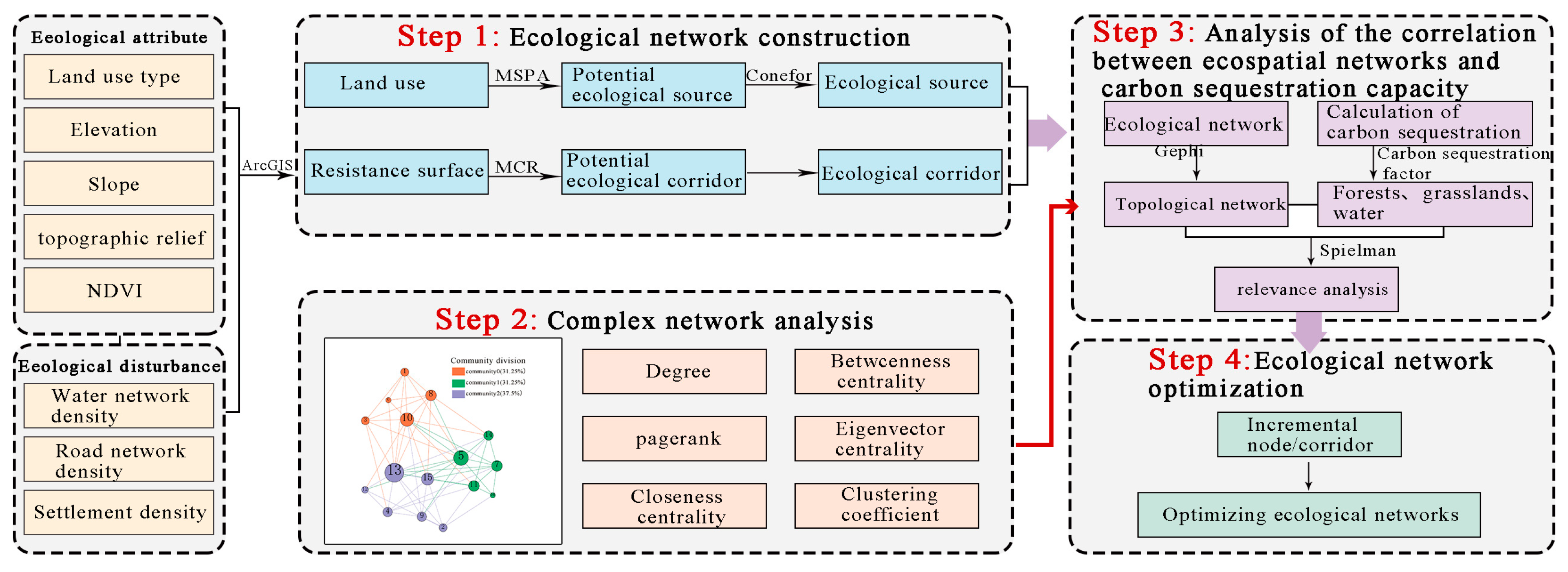
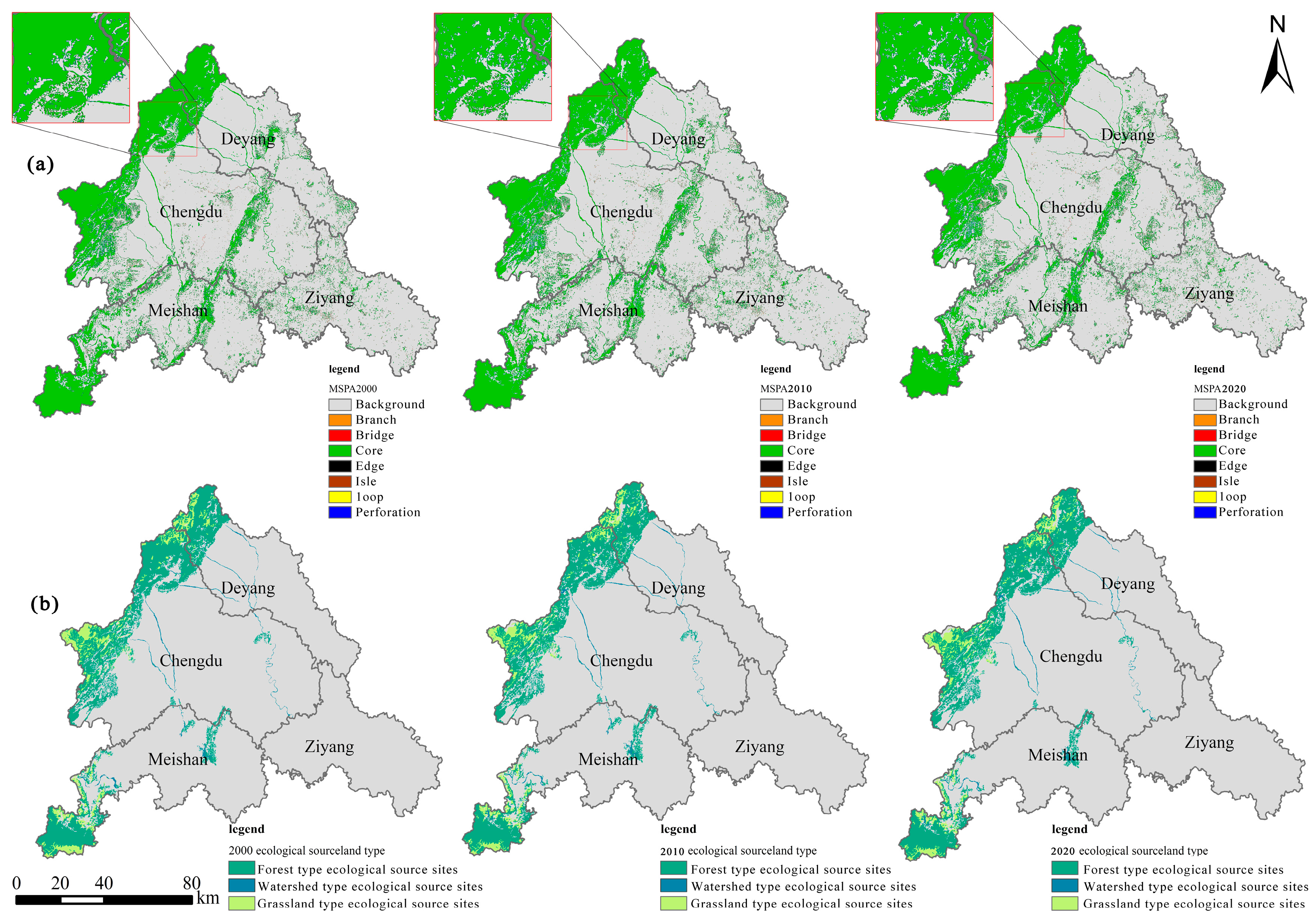
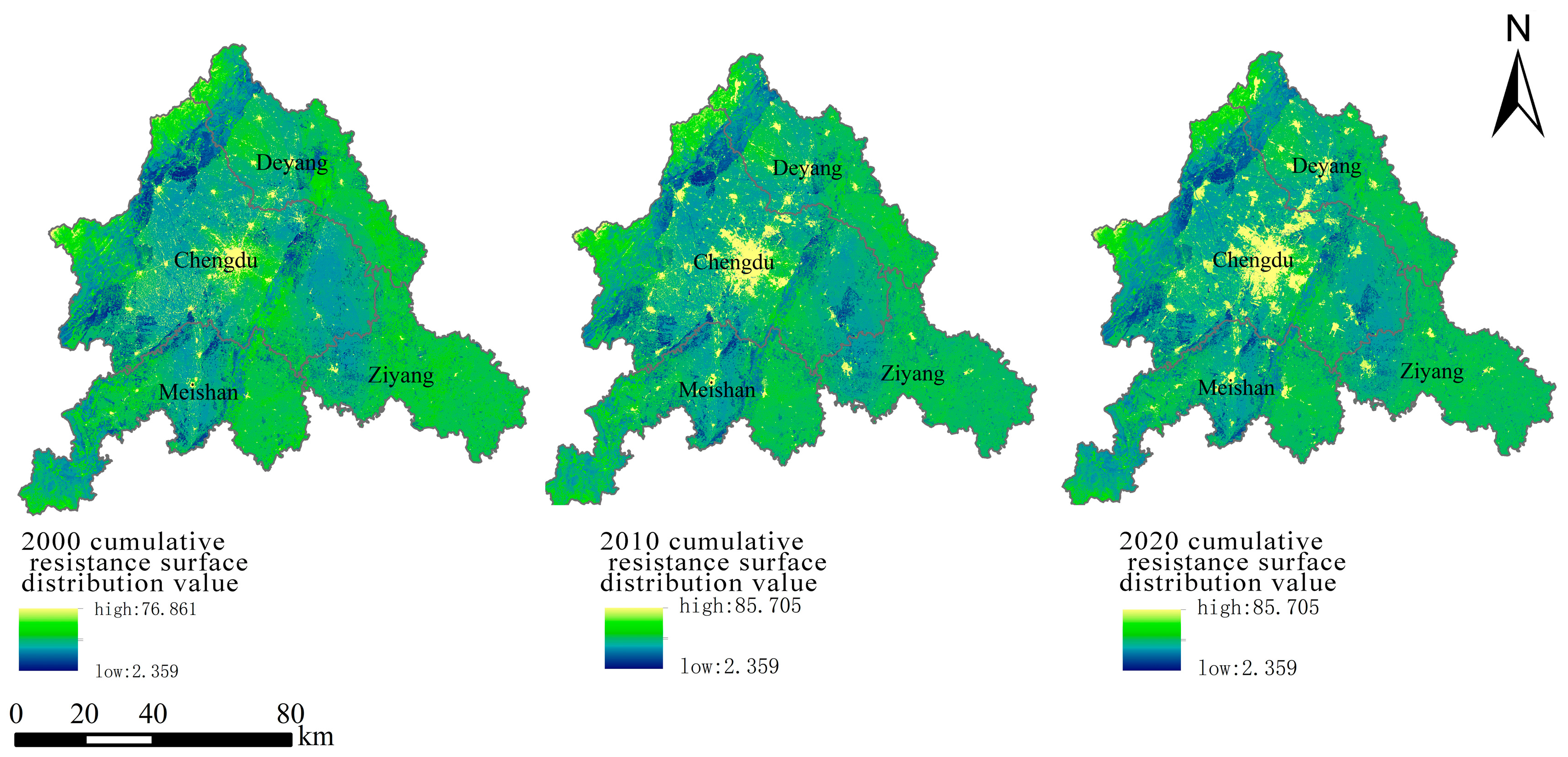
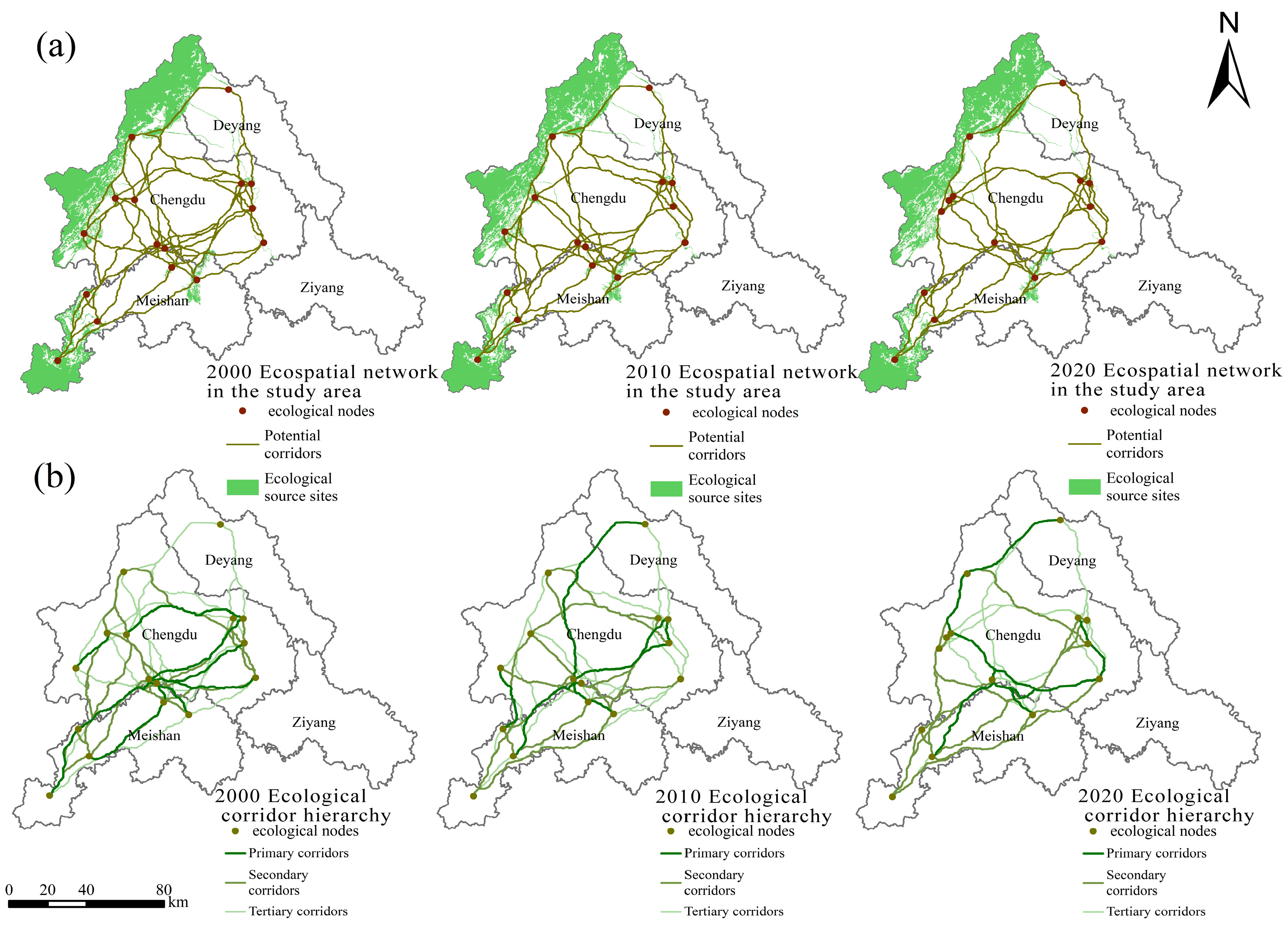
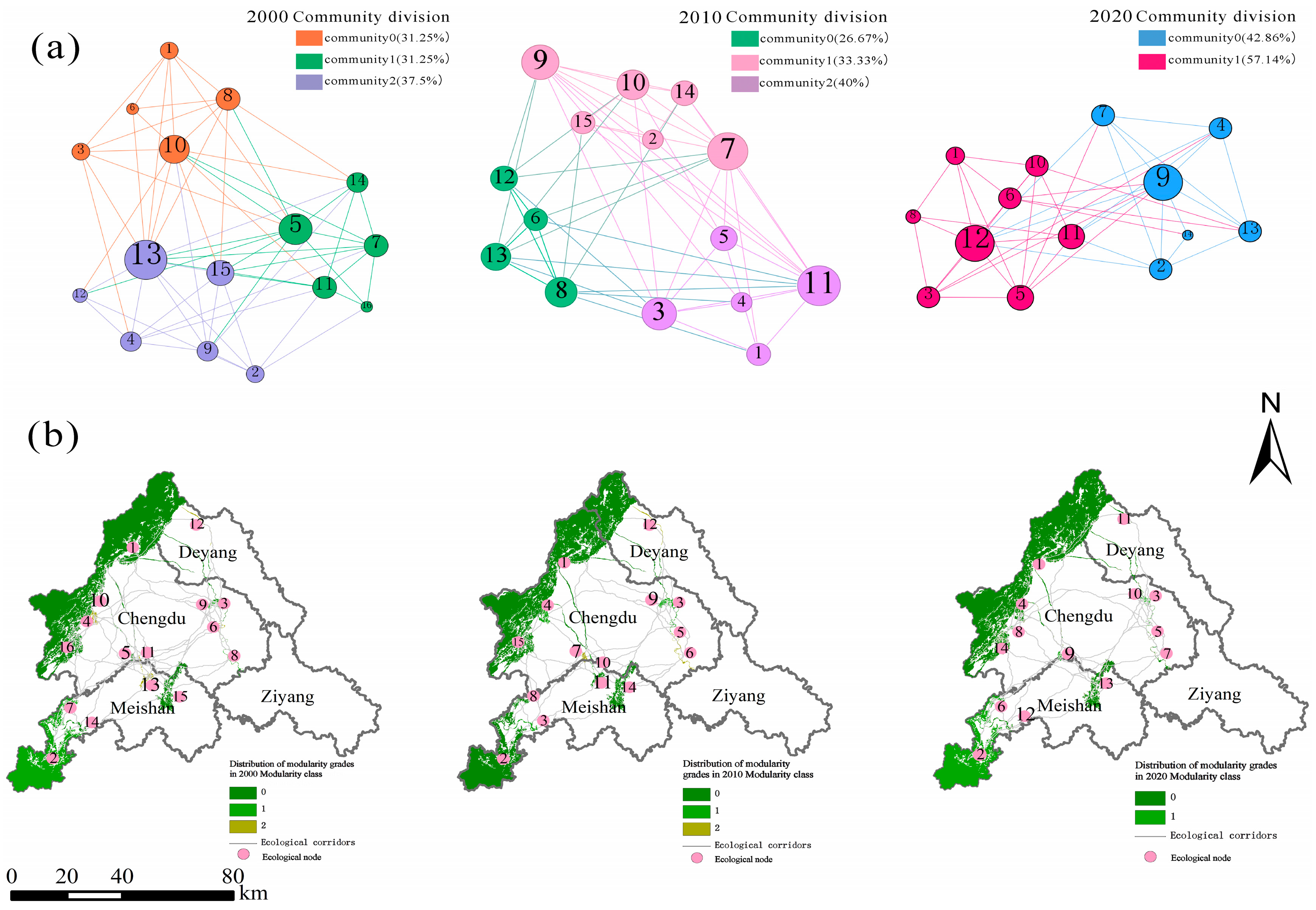
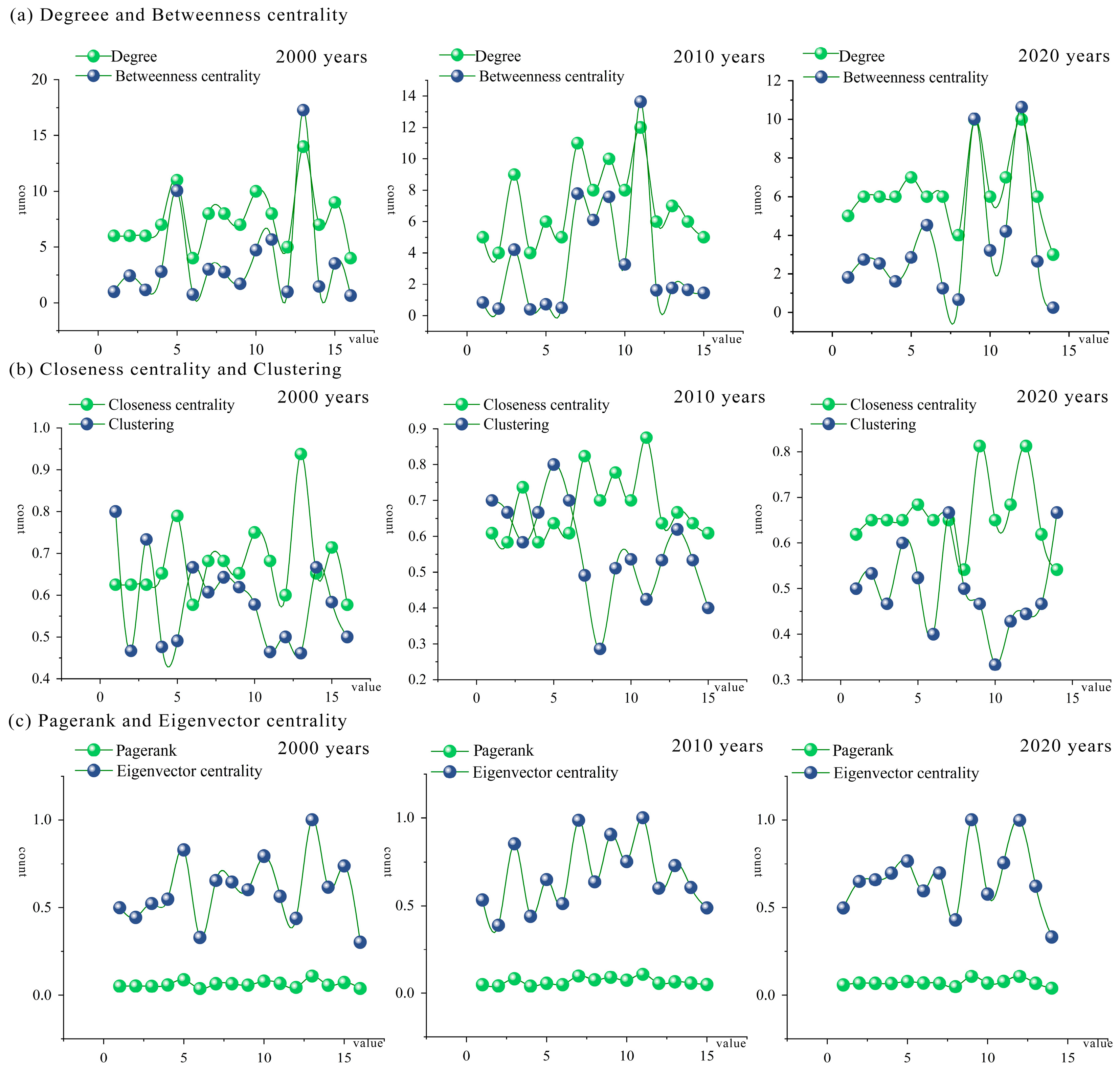
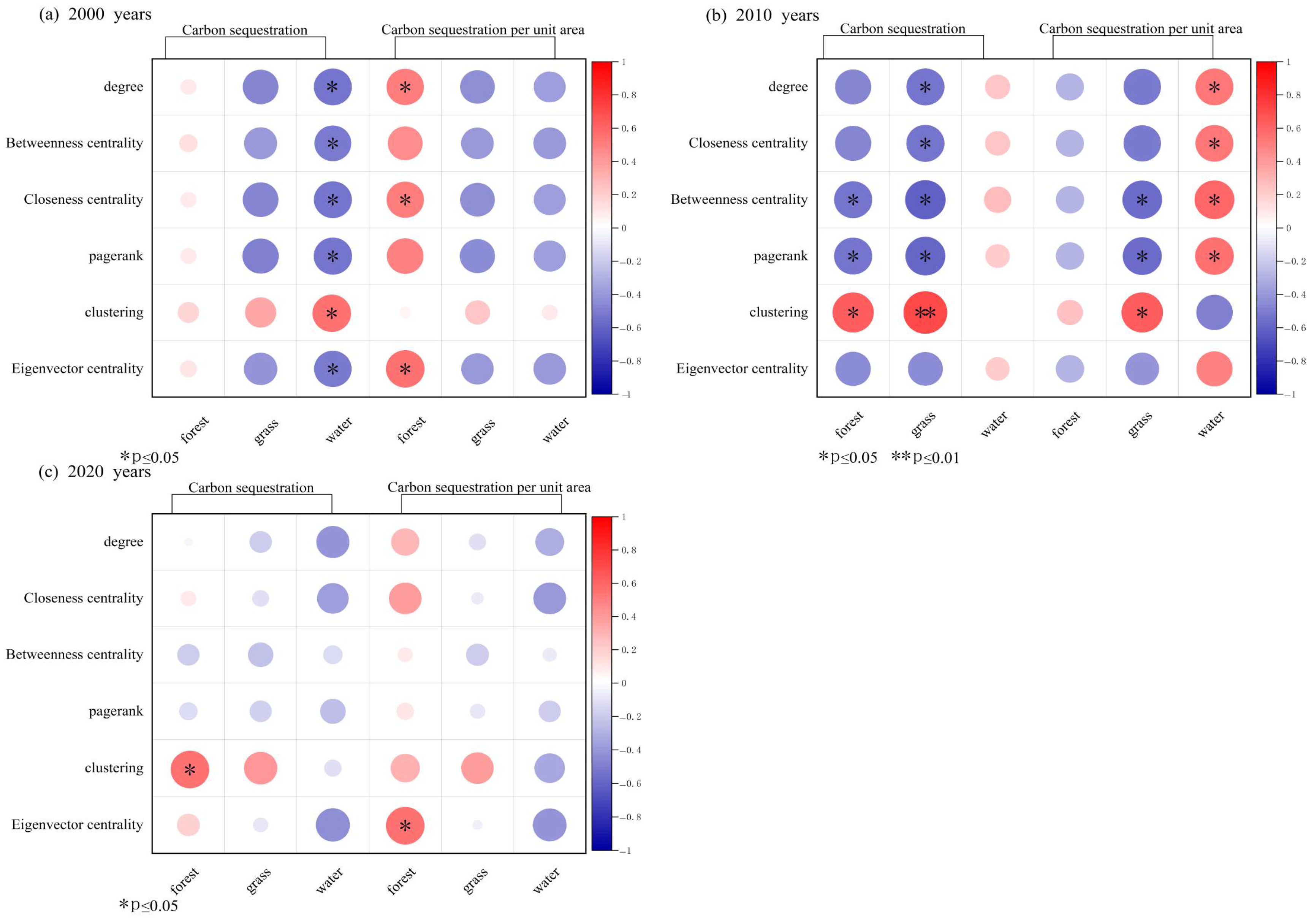
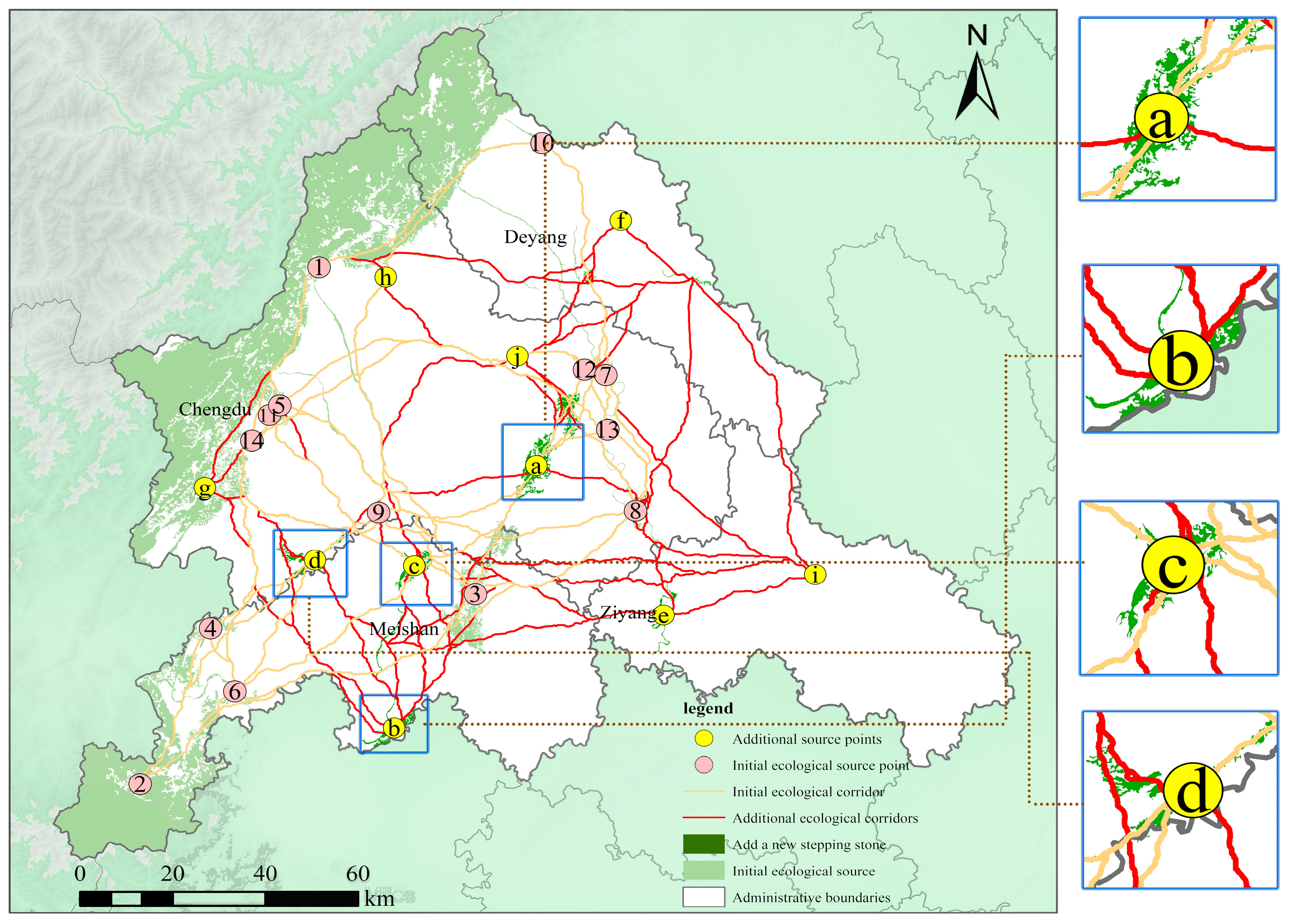
| Category | Data | Resolution | Data Source |
|---|---|---|---|
| Environment | LUCC | 30 m | Globe Land global surface coverage data (https://www.webmap.cn/commres.do?method=globeIndex, accessed on 30 January 2025) |
| DEM, slope, topographic relief | 30 m | Geo spatial data cloud (https://www.gscloud.cn/, accessed on 30 January 2025) | |
| NDVI | 30 m | Resource and Environmental Science Data Center of the Chinese Academy of Sciences (https://www.resdc.cn/, accessed on 30 January 2025) | |
| Socioeconomic | Road network | - | Open Street Map (https://www.openhistoricalmap.org/, accessed on 30 January 2025) |
| Water net | |||
| Demographic data | - | Data from World Pop website (https://hub.worldpop.org, accessed on 30 January 2025) |
| Resistance Factor | Weight | 1 | 10 | 20 | 40 | 70 | 100 |
|---|---|---|---|---|---|---|---|
| DEM/m | 0.15 | 216–553 | 553–936 | 936–1539 | 1539–2235 | 2235–3064 | 3064–7100 |
| Slope/° | 0.11 | 0–6.63 | 6.634–13.62 | 13.62–22.70 | 22.70–34.57 | 34.57–54.83 | 54.83–89.40 |
| Degree of topographic relief | 0.06 | 0.57–1 | 0.43–0.57 | 0.33–0.43 | 0.26–0.33 | 0.20–0.26 | 0–0.20 |
| NDVI | 0.10 | 201–254 | 186–201 | 169–186 | 145–169 | 109–145 | 0–109 |
| LUCC | 0.37 | Forest | Grassland | Water | Farmland | Unutilized land | Construction land |
| Water network density | 0.09 | 0–0.015 | 0.015–0.04 | 0.041–0.068 | 0.068–0.099 | 0.099–0.143 | 0.143–0.203 |
| Road density | 0.07 | 0–0.38 | 0.38–1.18 | 1.18–2.45 | 2.45–4.28 | 4.28–7.39 | 7.39–12.05 |
| Population density | 0.05 | 0–19.56 | 19.56–88.01 | 88.01–244.46 | 244.46–586.70 | 586.701–1271.19 | 271.19–2503.27 |
| Land Use Type | Carbon Sequestration Factor (t/hm2a) | Bibliography |
|---|---|---|
| Forest | 283.9 | [52,53] |
| Grassland | 143.8 | [54] |
| Watershed | 67.1 | [55,56] |
| Indicators/Years | 2000 | 2010 | 2020 |
|---|---|---|---|
| Degree | 7.5 | 7.067 | 6.286 |
| Pagerank | 0.063 | 0.066 | 0.071 |
| Closeness centrality | 0.676 | 0.679 | 0.658 |
| Betweenness centrality | 3.75 | 3.51 | 3.50 |
| Eigenvector centrality | 0.601 | 0.671 | 0.662 |
| Clustering coefficient | 0.579 | 0.563 | 0.50 |
| Particular Year | Main Land Use Types | Area (ha) | Total Source Area (ha) | Proportion of Total Ecological Resources | Carbon Fixed (Mg C yr−1) | Proportion of Total Carbon Sequestration | Total Carbon Sequestration (Mg C yr−1) |
|---|---|---|---|---|---|---|---|
| 2000 | Forest | 411,951.8 | 541,959.5 | 76.01% | 116,953,116.6 | 87.17% | 134,174,061.8 |
| Grass | 110,787.8 | 20.44% | 15,931,289.34 | 11.87% | |||
| Water | 19,219.91 | 3.60% | 1,289,655.84 | 0.96% | |||
| 2010 | Forest | 414,045.6 | 541,757.5 | 76.43% | 117,547,537.1 | 87.53% | 134,296,416.5 |
| Grass | 106,641.6 | 19.68% | 15,335,060.05 | 11.42% | |||
| Water | 21,070.33 | 3.89% | 1,413,819.28 | 1.05% | |||
| 2020 | Forest | 410,771.3 | 536,894.7 | 76.51% | 116,617,965 | 87.51% | 133,264,170 |
| Grass | 106,692.6 | 19.87% | 15,342,399.48 | 11.51% | |||
| Water | 19,430.78 | 3.62% | 1,303,805.522 | 0.98% |
Disclaimer/Publisher’s Note: The statements, opinions and data contained in all publications are solely those of the individual author(s) and contributor(s) and not of MDPI and/or the editor(s). MDPI and/or the editor(s) disclaim responsibility for any injury to people or property resulting from any ideas, methods, instructions or products referred to in the content. |
© 2025 by the authors. Licensee MDPI, Basel, Switzerland. This article is an open access article distributed under the terms and conditions of the Creative Commons Attribution (CC BY) license (https://creativecommons.org/licenses/by/4.0/).
Share and Cite
Hou, L.; Hu, H.; Liu, T.; Ma, C. Ecological Security Pattern Construction for Carbon Sink Capacity Enhancement: The Case of Chengdu Metropolitan Area. Sustainability 2025, 17, 4483. https://doi.org/10.3390/su17104483
Hou L, Hu H, Liu T, Ma C. Ecological Security Pattern Construction for Carbon Sink Capacity Enhancement: The Case of Chengdu Metropolitan Area. Sustainability. 2025; 17(10):4483. https://doi.org/10.3390/su17104483
Chicago/Turabian StyleHou, Langong, Huanhuan Hu, Tao Liu, and Che Ma. 2025. "Ecological Security Pattern Construction for Carbon Sink Capacity Enhancement: The Case of Chengdu Metropolitan Area" Sustainability 17, no. 10: 4483. https://doi.org/10.3390/su17104483
APA StyleHou, L., Hu, H., Liu, T., & Ma, C. (2025). Ecological Security Pattern Construction for Carbon Sink Capacity Enhancement: The Case of Chengdu Metropolitan Area. Sustainability, 17(10), 4483. https://doi.org/10.3390/su17104483






